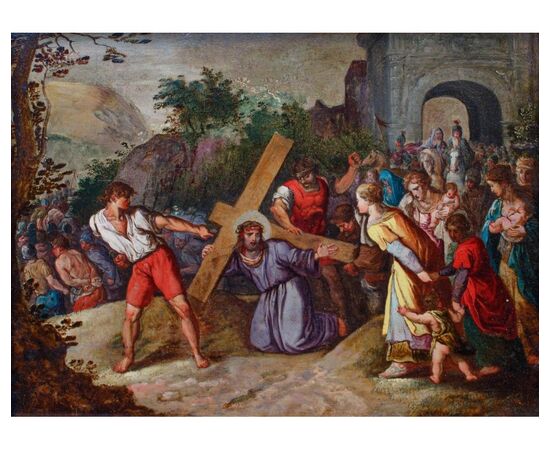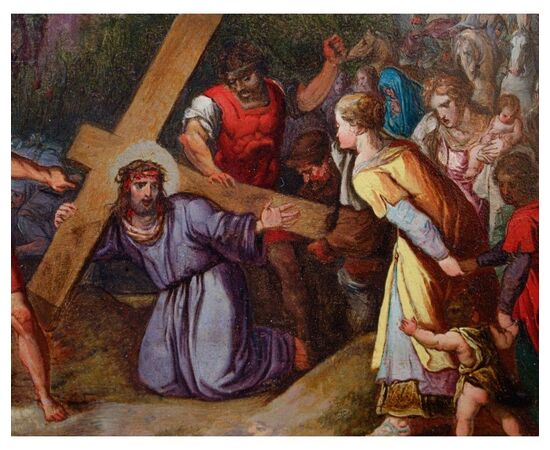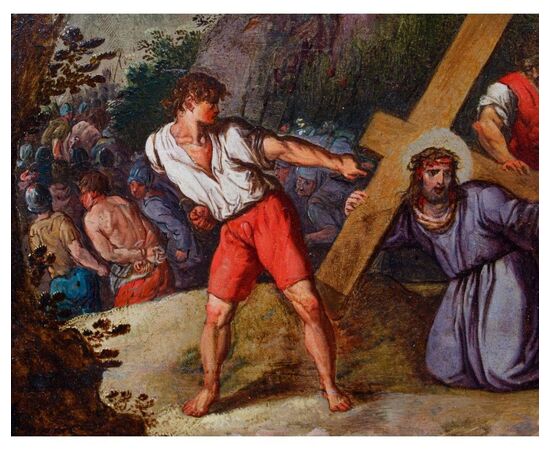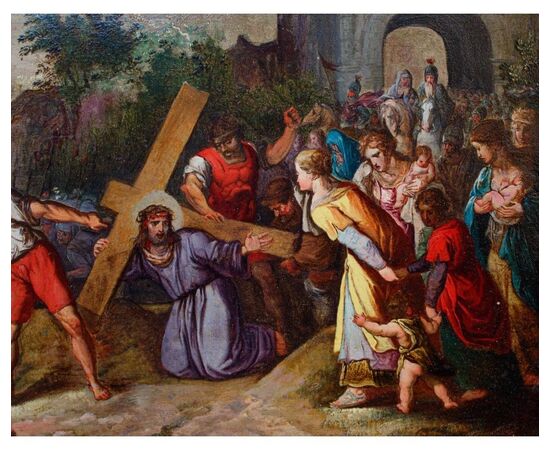Circle of Hans Jordaens III (ca. 1595 – ca. 1643) Christ Carrying the Cross
Circle of Hans Jordaens III (ca. 1595 – ca. 1643)
Christ Carrying the Cross
Oil on copper, 20.5 x 26 cm
This is a small copper panel of excellent execution depicting the episode of Christ carrying the cross to Calvary, relating to 17th-century Flemish production.
The episode of the ascent to Calvary is narrated in the canonical Gospels (Matthew 27:31-34; Mark 15:20-23; Luke 23:26-33; John 19:17-18). The story is told briefly by the Gospels and expanded particularly by Luke. After the sentence of condemnation, Christ, mocked and bleeding, was stripped of the purple cloak that had been placed on his shoulders in mockery, clothed in his own garments, and laden with the cross. According to Roman custom, the execution had to take place outside the city, along a particularly busy road, and the condemned man had to carry his own cross there, or at least its horizontal crossbar, called the patibulum.
The present work can be linked to the production of a Flemish painter, more precisely belonging to the circle of Hans Joardaens III (ca. 1595 – ca. 1643). The copper support also attests to its attribution to the Flemish sphere as it was easy to use when exporting their works to Europe; furthermore, the copper allows for a better lenticular rendering of details, among the typical characteristics of Flemish art. As in the art of Hans Jordaens III, there is also a sort of sensation of Horror Vacui, the space is filled with elements typical of Flemish Mannerism of Antwerp. The bright colors such as yellows and reds, as well as the treatment of shadows, also connect the copper panel to the art of Jordaens III.
Hans Joardaens III (Antwerp, circa 1595 – Antwerp, August 15, 1643) is the third exponent of an important family of painters who kept a workshop in Antwerp and is in fact a relative of Hans Joardaens I (Antwerp, circa 1555 – Delft, May 23, 1630) and perhaps son of Hans Joardaens II, from whom he received his initial artistic training.
In 1617 the beginning of his artistic career in Antwerp is documented, and it continued until 1643. In 1620 he also became part of the Saint Luke's Guild of his native city.
He dedicated himself mainly to painting historical subjects, interiors, animals, and the depiction of art collections in the style of Frans Francken II. He also collaborated with Abraham Govaerts, inserting figures into his landscapes.
Due to the artist's good standard of living, he lived in a large house despite the poverty of his family of origin, it is assumed that he obtained a certain success during his artistic career.








